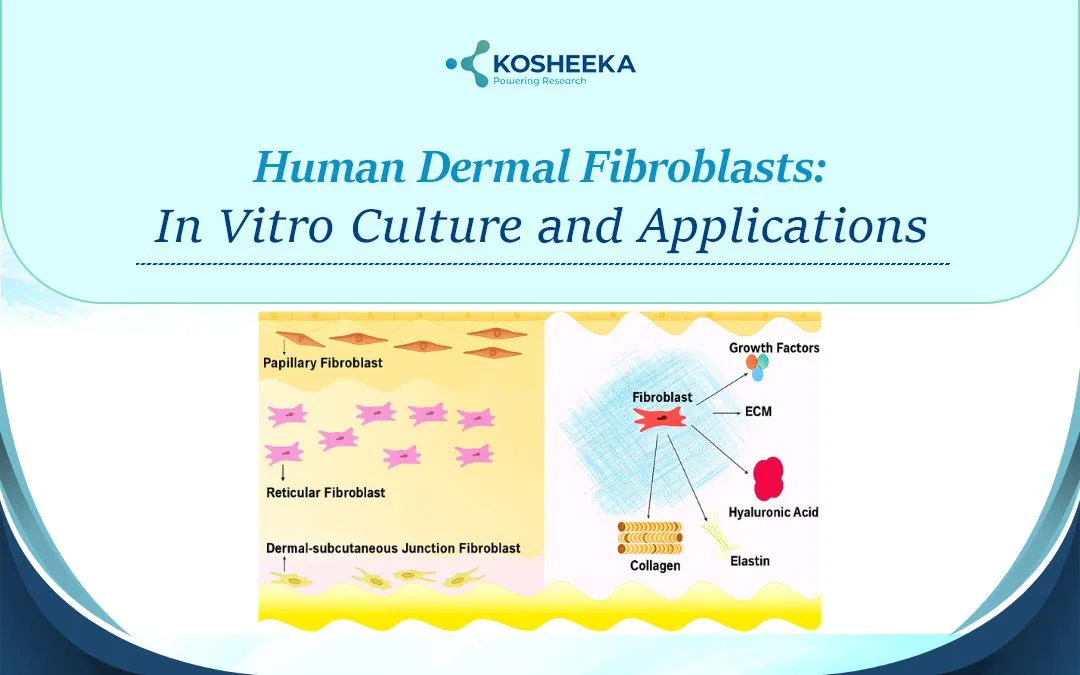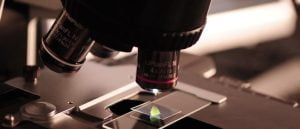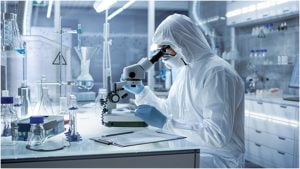Human dermal fibroblasts have broad applications in wound healing and tissue engineering. The dermis, a layer of skin underlying the epidermis, contains these spindle-like cells. They produce collagen, elastin, glycoproteins, and proteoglycans to maintain the structure of the skin. Skin is the largest organ and also the one that is in constant contact with the environment. Fibroblasts act as a safeguard for the skin from external assault by triggering an immune response. By interacting with other skin cells, they maintain tissue homeostasis.
The high availability of these cells has augmented their use in in vitro culture, particularly in regenerative medicine. They have applications in drug development for skin disorders and understanding the impact of aging. The development of Human Dermal Fibroblasts cell lines has notably enhanced research on these cells. This blog dives into fibroblast culture and research.
Human Dermal Fibroblast Culture
A thin slice of skin is sufficient to isolate dermal fibroblasts. After separating the dermis from the epidermis by enzyme, enzymatic digestion or explant culture is employed. Enzymatic digestion disperses cells from tissue. Explant culture involves placing dermis in a tissue culture plate. It eventually leads to the migration of cells into the plate. For research, dermal fibroblasts are either obtained from adult skin or neonatal foreskin. After a few days, separated cells are sub-cultured in a fresh medium. Fibroblasts are cultured in a 6-well plate to enhance cell-cell contact and improve their growth. During the culture, researchers often face a few issues. Here are a few tips to troubleshoot the problems in the dermal fibroblasts culture:
- Medium: The suitable culture medium of fibroblasts are fibroblast growth medium and Dulbecco’s Modified Eagle Medium (DMEM). Additionally growth factors like ascorbic acid 2-phosphate and FGF2 can be added.
- Cell Adherence: Typically, fibroblasts can grow on a standard tissue culture plate. However, coating plates with gelatin or seeding a higher quantity of cells can resolve the cell adherence issue.
- Slow Growth: On average, skin fibroblasts can proliferate up to 15 passages. The cell growth might slow as the higher passage number is reached.
Human Dermal Fibroblast Cell Line
Primary fibroblasts have finite lifespan. Researchers either should plan appropriately to establish experiments at the earlier passages or before they reach the last passage. It might also require repeating the isolation to either obtain more cells or cells with early passages. Oftentimes, the short lifespan also restricts the amount of cells available for an experiment. Immortalized Human Dermal Fibroblast Cell Lines overcome these setbacks.
Their indefinite lifespan minimizes the need for repeated procurement of cells and precise planning of experimentation. Therefore, researchers frequently use cell lines instead of primary fibroblasts. However, the choice of primary cells vs cell lines is difficult and requires thorough deliberation. Patient-derived primary fibroblasts can accurately delineate the disease mechanisms. On the contrary, the homogeneity of cell lines reduces the variation in study results in comparison to primary fibroblasts pooled from different donors.
Human Dermal Fibroblast ATCC
American Type Culture Collection (ATCC) is a center with a wide array of cells and cell products. It serves as a global repository that maintains cells and also banks the cells/cell lines developed by other laboratories. Established in 1925, ATCC has upheld the highest standards in cell banking and has become the most extensive collection of cells in the world. Below is the list of attributes that build trust and reliability of ATCC cells:
- Authenticated Cells: Each cell is authenticated by the most recent and advanced techniques which ensure their identity and purity.
- Documentation: ATCC also keeps a detailed documentation of donor or cell line development that confers traceability of their products.
- Accreditations: ATCC has received ISO and other certifications for following the international guidelines of different aspects of Cell Culture, maintenance, and transportation.
All these factors contribute to the preference of ATCC cells over cells from other sources. For human dermal fibroblasts, ATCC offers the following options:
- Primary Adult Human Dermal Fibroblasts
- Primary Neonatal Human Dermal Fibroblasts
- hTERT- skin fibroblasts (CRL-4066): Cell line developed by the hTERT immortalization method
- WS1 (CRL-1502): Skin fibroblasts from a Black female donor
- HFF-1 (SCRC-1041): Primary Adult Human Dermal Fibroblasts
Research Applications
Regenerative Medicine
Fibroblast transformation into iPSCs has generated substantial interest in the scientific community. The relatively easy availability of these cells has promoted their use for the development of iPSCs. iPSCs are then differentiated into specific cell types to utilize them in research or cell therapies.
Wound Healing
Wound repair and scar formation processes are extensively studied on skin. Fibroblasts are the key mediators of these processes by depositing extracellular matrix proteins like collagen. They also regulate immune response, angiogenesis, and ECM remodeling- the mechanisms behind repair. In vitro research on fibroblasts increases the understanding of these processes and enables the development of wound healing medications.
Skin Disorders
Disorders such as psoriasis, melasma, atopic dermatitis, baldness, etc., occur due to inflammation and cellular dysfunction. Both keratinocytes and fibroblasts participate in the signaling behind these events. Research studies have suggested that the cellular cross-talk between both cell types impacts these disorders. Therefore, fibroblast research can reveal more mechanisms behind the skin disorders.
Drug Screening
Fibroblast isolated from a patient’s skin can serve more than one purpose. On the one hand, they are accurate disease models for drug discovery. On the other hand, they can be employed to evaluate drugs to measure the effectiveness and even the toxicity of drugs. Analysis of several cosmetic formulations on skin cells is customary before circulation into the market.
Latest Research
3D Skin
The development of artificial skin began in the late 20th century. However, they were either based on keratinocytes or fibroblasts. Now, researchers are creating 3D skin constructs with different skin cells, including fibroblasts. These constructs more accurately mimic the tissue suitable for research purposes.
Single-cell RNA (scRNA) Sequencing
scRNA sequencing has become quite popular for identifying different populations at the genetic level. Recent research has established that the fibroblast population comprises diverse cell subsets that have distinct roles in inflammation, ECM remodeling, and aging. The scRNA sequencing can aid in studying these subsets that lack distinguishable protein markers.
Product-Related Queries, Or Partnership Inquiries
Final Thoughts
Human dermal fibroblasts have a profound effect on biomedical research. The studies expanded their role from only producing ECM to wound repair, which propelled more research on these cells. This led to exploring their role in skin immune response. Their applications broadened with their in vitro dedifferentiation into iPSCs. Despite their relatively easy availability, their in vitro culture can be troublesome, prompting researchers to opt for cell lines instead of primary fibroblasts. ATCC is the gold standard for cell collection and maintenance. It offers both options- primary cells and cell lines. Kosheeka provides ATCC cell lines and primary human dermal fibroblasts to enhance the credibility of your research. The scientific team of Kosheeka can also customize the cells according to a specific donor profile to instill precision in your research.
FAQ’s
Q- What are human skin fibroblasts, and why are they important in research?
These are connective tissue cells found in the dermis layer of the skin. They play a vital role in producing extracellular matrix components like collagen and elastin, making them essential for studies in wound healing, skin regeneration, and tissue engineering.
Q- How are skin fibroblasts cultured in the lab?
HDFs are typically isolated from skin biopsies and cultured in DMEM with 10% FBS. Medium can be supplemented with additional growth factors, such as FGF, ascorbic acid, etc.
Q- What is the role of ATCC in sourcing dermal fibroblasts?
It provides authenticated, high-quality fibroblast cell lines—both primary and immortalized—with detailed documentation. These standardized cells ensure reproducibility, safety, and regulatory compliance in scientific research.
Q- What are the latest advancements in skin fibroblast research?
Recent research includes 3D skin models for more accurate testing, single-cell transcriptomics to uncover cell subtypes, and fibroblast reprogramming into iPSCs for personalized medicine and disease modeling.



